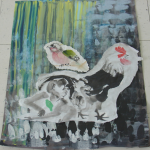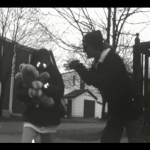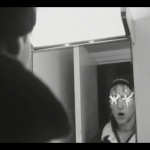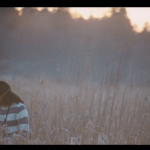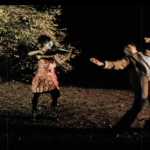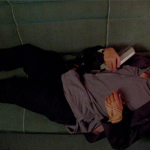IN SEARCH OF UNIVERSALITY: SOCIAL MOVEMENTS, INTERDISCIPLINARY ART AND EXPANDED MEDIA
When I first came to Canada about 15 years ago, I moved to a small town on the East Coast. Being one of the only visible minority people in town wasn’t easy. I found Hip Hop as a shelter for my discomfort and utilized it as a form of expression that withstood racial stereotypes. Looking back, much of my earlier work between 2003 and 2006 revolved around themes of racism, identity and migration. I became aware of these issues through the experience of being in Canada while having come from an ambiguous country; I was born in Taiwan, a place still struggling for its identity as well.
After playing with music and painting, I encountered film, a medium that seemed the most versatile and multidisciplinary for me at that time. Through the Atlantic Filmmakers Cooperative’s scholarship, I made my first 16mm short film, Scratchhh (2004). The main theme of this work is racism. In the film, all the characters’ eyes are scratched off. The main character despises these characters throughout the film, until he realizes that his eyes are also missing. Executing the frame-by-frame scratch animation technique marked my increasing dedication to art, especially in how it voices desires for social justice and equality. (One night, I spent eight hours straight scratching the film so that the characters‘ eyes could convey metaphorically the idea that we need to awaken our true vision for this world.)
Soon after, I made Beneath the Surface (2006), a film about discrimination. The main character is bullied due to her appearance — messy hair, oversized clothing and an odd black box that she carries around with her. We discover that the box contains beautiful photos connected with her memories that remain unknown to the viewer. Another film, Gradient (2006), is about two young men meeting at the harbour — one is returning from a journey and one is just about to depart. The two share their stories, revealing anticipation for the departure and harsh disillusionment of the journey. In the end they stand in the harbour and await the break of dawn. The film took on a more poetic and magical realist approach in its dialogue and imagery than the conventional narrative films, in the hopes of eliciting the viewer’s imagination and sensorial perception in cinema, as well as in the context of our everyday lives. I was fascinated by phenomenology, which encourages viewers to take a primordial and non-prejudiced view of the world and to re-embody our senses with our surroundings. The impetus of this film had come from a very harsh romantic love encounter that my film collaborator, Jimmy Hsu, and I were facing at that time. It is clear to me now that these films seek to voice the values that exist deeply within each one of us. They ask us to look beyond our banal senses and transcend conventional social values.
In my later film works, Oceanic (2009) and Patterns of Liquid Stars (2011), I created characters that were ambiguous in terms of gender, race, cultural background and social class. I strive to break the common rules for screenwriting in the hopes of challenging the viewers to see beyond the stereotypes that are so prevalent in our screen culture today, especially after the excruciating disaster of Hollywood cinema. In conventional screenwriting, we’re taught to create characters that are as obvious as possible in order for the spectators to identify and relate to them. The pitfall of this convention is the resulting vicious cycle of stereotypes and clichéd character representations. Growing up in places that are unconsciously dominated by Hollywood stereotypes, I noticed how Asian males entail impressions of non-romantic and flat characters who are only relevant to martial arts or comedic roles. The result of this has brought tremendous hardship and prejudice against this particular ethnic group in real life. Asian males continue to be under-represented in the Western mainstream media, not to mention how other ethnic groups are misrepresented; such things are noticed only when watching with a culturally cultivated eye. Hence, I strive to ameliorate this situation at the point where screen culture begins: screen writing. I wanted to change what’s happening with our screen culture in the present. While it’s an ambitious undertaking, I felt it worth experimenting rather than just conforming to the injustices embedded in the cultural apparatus.
Oceanic and Patterns of Liquid Stars move along in a dreamlike, trancelike and surreal spatiotemporal logic. If our dreams are able to transcend reality, then why can’t we filmmakers free ourselves from the conventions of cinema restraining our creative vision? Are we merely slaves to our ideologies, or are we able to deconstruct our pre-existing identities? One way to challenge these limits is through integrating different elements, mediums and methods; the insurmountable conventions and constraints may then begin to disintegrate. Hence, these two films combine digital video, analogue film techniques, digital projection, interactive media, contemporary dance, theatrical mise-en-scène and hand drawn animation. I believe that if the conventional viewpoints that define cinema are challenged, preconceived ideas may begin to dissolve and new perceptual doors may begin to open up.
This idea of dissolving formats and genres is closely connected with my encounters in new media arts and technology. It was a revelation that I didn’t need to rely on traditional tools to make art any more. Instead, artists can make our own vehicles to convey our vision. I went on to participate in numerous collaborations involving new media technologies in various settings, so often that people wondered, “Are you a filmmaker, musician, visual artist or computer programmer?”
To take the interdisciplinary and intercultural idea even further, I have danced onstage with dance master Wen Wei Wang in the ongoing collaboration Made In China. With this project, we are exploring our personal memories, heritages and migrations through the process of interdisciplinary collaboration. Moreover, we seek to challenge viewers about their impressions of China by using traditional practices in a contemporary context. Although it’s an ongoing experiment, I discovered a scathing review condemning the performance. On one hand, I could ignore the unthinking and conservative views of the writer; on the other hand, the review has raised some simmering questions for me about whether our spectators today still harbour conservative perspectives on cultural representations. Every ethnicity has already been predetermined for the public by mainstream representations of ethnic cultures. Are we able to escape this “cultural gaze” that is forced upon us? Do we still need to ask ourselves if we are “exotic” or “cultural” enough for our audience? I naïvely believe that art is a universal language that is licensed to unfetter us from the ideology of mainstream consumerism and the entertainment apparatus.
In March 2014, I made a trip back to Taiwan, where I was born. Just when I was about to return to Canada, a very profound social movement happened. They called it the Sunflower Movement. It started as a student movement occupying Taiwan’s parliament building and exposing the government’s plan to push through a major trade deal with China — a deal with tremendous economic, cultural and political issues at stake. As one example, the changes would allow Chinese citizens to immigrate and make investments in Taiwan much more easily. As an immigrant, an Asian-Canadian and a global-minded artist, I didn’t think it was an issue. My skepticism with politics had me wondering if the protest was merely a form of xenophobia and discrimination against the Mainland Chinese. I was ambivalent about supporting this occupation until I stopped watching the news and started physically visiting the site — it turned out to be one of the most fascinating protests I’ve ever witnessed.
Ian Rowen compares the Sunflower Movement with Burning Man and Occupy, noting that, “The polite conduct, festive atmosphere, filial relationship with police, sophisticated use of high-tech tools, commitment to sanitation and recycling, and a high degree of order in this dynamic environment recalls Burning Man more than Occupy, which lacked a consistent leadership core.”1 Rowen describes how almost everywhere within the occupation zone you can find creative use of visual and performance arts by the protesters to articulate and spread their messages. He continues, “In fact, it could also be argued that the parliamentary occupation itself was a kind of avant-garde performance art, in which students refashioned a failing and derelict public institution into a model of efficiency and high-tech coordination. This was a people’s Parliament that engaged in deeper discussion of the law than it did when run under normal auspices.”2 In this respect, the students and activists were using artistic means to educate elected lawmakers as to their duties and obligations.
American writer Karen Bender was impressed by the Sunflower Movement and particularly by “how they used art and creativity in ways to connect and motivate one another. The fact that protesters organized this peaceful occupation under the shadow of a country that does not support free speech, is brave in a way that could inspire Americans to speak up for their own interests.“3 The anxiety of losing free speech is their biggest fear! By actually being inside the scene, I was able to perceive more factual information. One of the main goals for protesters is to protect the Taiwanese lower and middle classes from the likelihood of larger corporations and investors superseding the rights of the people from outside of Taiwan. Moreover, there’s the fear of losing freedom of speech due to the Chinese communist government’s control of publishing and media. Primarily, the protesters strongly state that the future of their nation should be decided by the people, not only by the members of one political party. Yet, being on the outside, the only way to receive information was through mass media or social networks. The media distorted it as an uncivilized riot and even falsely reported the goal of the protest. As a result, Taiwanese citizens took extreme sides, which caused tremendous tension and discrimination against each position. To me, they were all victims under the control of the media and politicians. I realize that it’s human nature that we function by stereotypes and self-identity, something that can potentially lead to larger issues such as xenophobia and racism. However, I also realize that mainstream media constantly aggravate this condition — they often over-simplify, generalize and exaggerate information, which leads the viewers from ignorance to prejudice on discourses that may require deeper perspectives.
While I was touched by the students and the activists, I knew that something was missing — an alternative portal that connects everyone together, something that channels to the rest of the world. I decided to create a net art project with my collective Chimerik 似不像 called I Hear Your Voice.com4 which utilizes websites as alternative platforms for people to voice themselves and to listen to each other. We implemented code from experimental sound synthesizers and used evocative wording to guide the participants inward (for each one to find his or her own voice), while guiding them away from superficial thoughts and aggressive comments. Once your voice gets sent out, someone somewhere in this world may receive and respond to your message. In the end, the participant leaves with a surprise image with their voice and a response from someone unknown. We can see this as an image of our inner voices conjuring with the positive spirits of the movement. The user is left with a digital postcard from the efforts of someone from somewhere in this world, while knowing that there are presumably numerous people waiting for their voices to be heard. What can we do for them?
I know that deep down there is always something universal within each one of us — the values of culture, civilization, justice, liberty and great spirits. Yet, often we are stuck on the surface level: our look, our clothes, our skin colour, our gender, our social class, our profits, as well as our views on politics, nationalism and religion. I believe that art is the alternative door that channels us to a deeper realm, and also connects us on a human-to-human level that we may have yet to experience.
In looking back, from my very first black and white experimental film to my latest new media net art project, I noticed something important. Although the evolution of technology has made the forms and possibilities apparently very different from work to work, I realized the essence of each of these artworks still resonates across media. These works share similarities in redefining identity, breaking boundaries, looking inward and looking beyond surface semblance; perhaps there is one very important thing that we may be forgetting — the love for humanity and the love for this world — this should be universal.
My intuition guided me to interdisciplinary art and technology possibly because interdisciplinary art disfigures identity and new media is the vehicle that can take us to new places that can still elevate up from the growth of mass media. We can then keep searching for doors that may lead us to deeper places, to where our soul and spirits belong: somewhere that shares universal values; somewhere that is transracial, transnational and transcultural. Finally, we can then smile, embrace our differences and celebrate ambiguity.
NOTES
1. Ian Rowen is one of the core members of the movement as well as Burning Man’s regional contact for China and Taiwan, “Inside Taiwan’s Sunflower Movement — Where Asia’s Largest Student Uprising is Blooming,” Occupy.com, accessed April 2, 2014: Link
2. Ian Rowen, e-mail message to author, May 7, 2014.
3. Karen Bender, e-mail message to author, May 7, 2014. http://www.therivetermagazine.com/fighting-for-democracy-the-story-of-the-taiwanese-sunflower-movement/ & http://www.
4. I Hear Your Voice.com is created by Chimerik 似不像 with Trippo 山人整合創新 and contributors Hsieh Tai-ju 謝岱汝, Andria SUN Chih-shi 孫志熙, Chen Wei 陳瑋, initiated in the group exhibition Produce, Consume curated by Matt Troy at Grunt Gallery, funded by the Canada Council’s Project Grants to Media Arts Organizations, Groups and Collectives, Audain Foundation, City of Vancouver, and the British Columbia Arts Council. http://ihearyourvoice.com
All images courtesy the author. The images were made possible by the generosity of Alex Balkam and Julie MacRae of AFCOOP, Betty Apple, Shang-Han Chien, Daidai Tai-ju Hsieh, Andy Lee and Sophia Wolfe.
Image credits:
Photo 1: Snapshot of Sammy performing rap with Alpha Flight at Cyber in Halifax, Nova Scotia, 2004; 2: Protect Ya Land, mix media, 2003; 3: One Nation Under the Truth, watercolour, 2003; 4: Screenshot from Scratchhh, 2004, with Matthew Langille, Daisy Cobden; 5: Screenshot from Scratchhh, 2004, with Daisy Cobden; 6: Screenshot from Scratchhh, 2004, with Michael Jeon, Francis Fleming, Andrew Doan; 7: Screenshots from Scratchhh, 2004, with Matthew Langille; 8: Beneath the Surface (2006), with Rachel Chen; 9: Gradient (2006), with Sammy Chien; 10: Gradient (2006); 11: Gradient (2006), with Jimmy Hsu; 12: Gradient (2006), with Sammy Chien, Jimmy Hsu; 13: Beneath the Surface (2006) with Victor Pan; 14: Oceanic (2009), with Marc Arboleda, Davy Bisaro; 15: Oceanic (2009), with Marc Arboleda; 16: Oceanic (2009), with Marc Arboleda; 17: Oceanic (2009), with Marc Arboleda, Anny Lin; 18: Patterns of Liquid Stars (2011), with Marc Arboleda; 19: Patterns of Liquid Stars (2011) with Shang-Han Chien’s animation; 20: Patterns of Liquid Stars (2011), with Marc Arboleda, Felicia Lau, Erika Mitsuhashi, Jessie Kwan, Kaylin Metchie; 21: Patterns of Liquid Stars (2011), with Tiffany Choi; 22: Patterns of Liquid Stars (2011); 23: Patterns of Liquid Stars (2011), with Trevor Lim; 24: Made In China, Dance In Vancouver Festival 2013, Sammy Chien with Wen Wei Wang and Gao Yanjinzi of Beijing Modern Dance Company, photo by Sophia Wolfe; 25: (two photos joined) Sammy and 500,000 people gathered for the protest event with high degree of organization and disciplines, leaving the street clean afterwards, photo by Andy Lee and Hsieh Tai-ju; 26: Protesters utilizes music, film, graffitis and art installations to convey their messages, photo by Hsieh Tai-ju; 27: (Using music to change the world) Sammy spotted one of the protester’s inspiring shirt.; 28: (two photos) Protesters utilizes music, film, graffiti and art installations to convey their messages. Graffiti says “guard our democracy”, “we insistence to make our own decisions”.; 29: Protesters camps over night for 3 weeks, surrounded by lectures, poetry, film screening, art, music performances, very much like a huge outdoor art festival by the parliament’s building.; 30: People donates food, clothes, blankets, etc for the protesters. This coffee is sold as honest system.; 31: Taiwanese contemporary artist Betty Apple posing in front of an art installations in the scene. She’s one of the main pusher on the art side of this social movement.; 32: They even offer free social service on site, such as mental-wellness and psychiatry; 33: Through Sammy’s activist friends, he found his way into the parliament’s building, witnessing the core of the social movement, photo by Shang-Han Chien; 34: the core scene is filled with media, social organizations and intellectual elites.; 35: Some protesters slept there for over 20 days, almost seem like an intensive summer camp for social activists and political artists; 36: Sammy with the riot police, photo by Chen, Wei; 37-41: screenshot of the netart project “I Hear Your Voice. Com”


